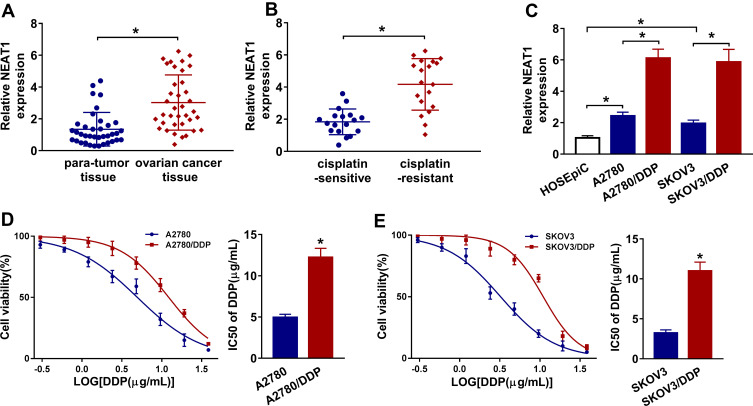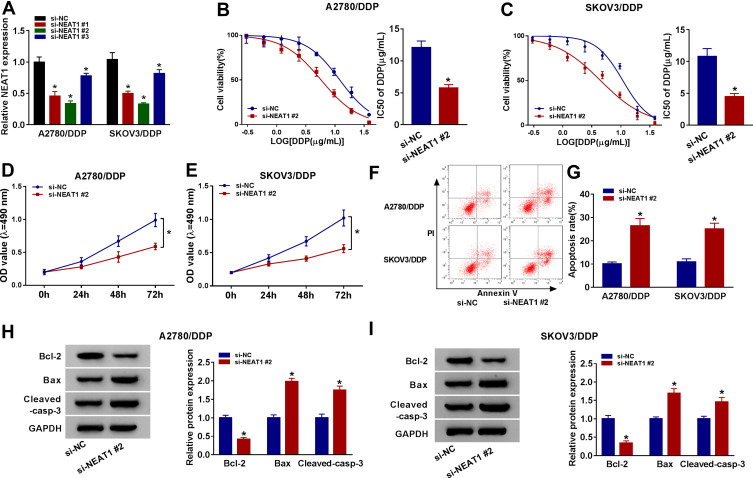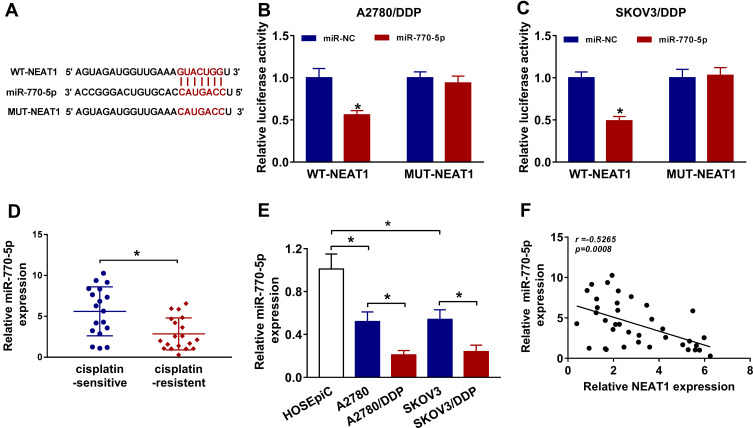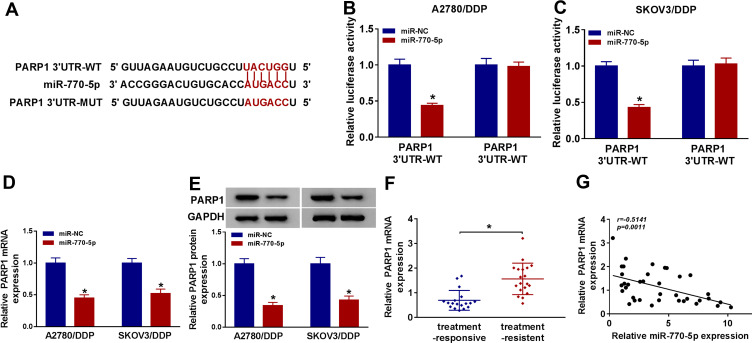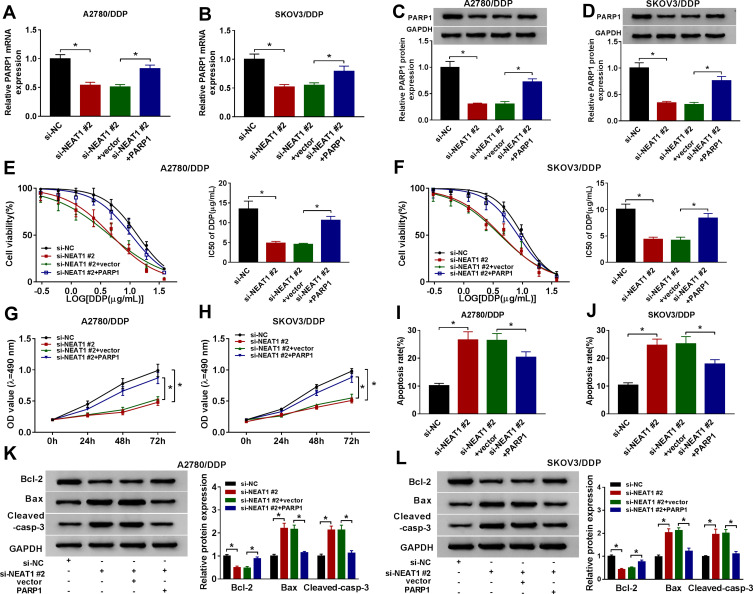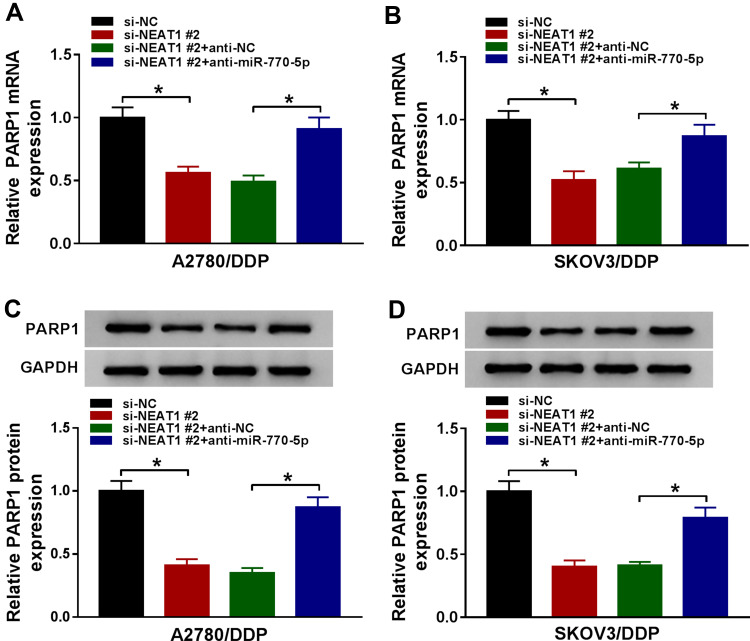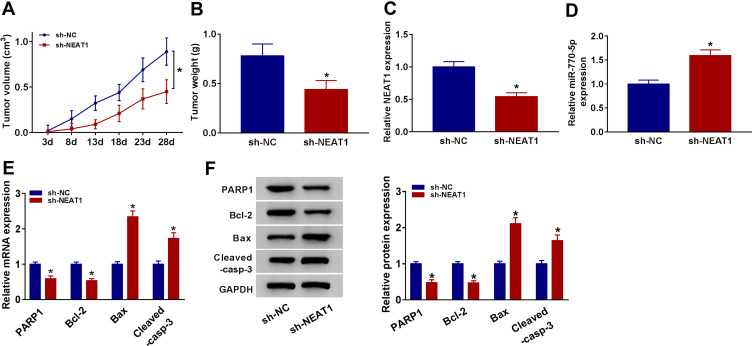Abstract
Background
Long noncoding RNAs play essential roles in regulating drug resistance in cancers. However, how and whether lncRNA nuclear paraspeckle assembly transcript 1 (NEAT1) could mediate cisplatin resistance in ovarian cancer remain poorly understood.
Patients and Methods
Eighteen cisplatin-sensitive and 19 cisplatin-resistant patients with ovarian cancer were recruited. Cisplatin-resistant ovarian cancer cells were used for this study. The expression levels of NEAT1, microRNA (miR)-770-5p and poly adenosine diphosphate-ribose polymerase 1 (PARP1) were detected by quantitative real-time polymerase chain reaction or Western blot. Cisplatin resistance was assessed by the half-maximal inhibitory concentration (IC50) of cisplatin, cell viability and apoptosis using 3-(4,5-dimethylthiazol-2-yl)-2,5-diphenyl-tetrazolium bromide, flow cytometry and Western blot, respectively. The target association between miR-770-5p and NEAT1 or PARP1 was investigated by dual-luciferase reporter assay. The xenograft model was used to investigate cisplatin resistance in vivo.
Results
NEAT1 expression is elevated in cisplatin-resistant ovarian cancer tissues and cells. Knockdown of NEAT1 repressed cisplatin resistance by decreasing the IC50 of cisplatin, cell viability and increasing apoptosis. MiR-770-5p was bound to NEAT1 and PARP1 was confirmed as a target of miR-770-5p. MiR-770-5p inhibition or PARP1 restoration could abate the effect of NEAT1 silencing on cisplatin resistance in cisplatin-resistant ovarian cancer cells. Moreover, NEAT1 knockdown reduced PARP1 expression by increasing miR-770-5p. Interference of NEAT1 decreased xenograft tumor growth by regulating miR-770-5p and PARP1.
Conclusion
Knockdown of NEAT1 inhibited cisplatin resistance in ovarian cancer cells by up-regulating miR-770-5p and down-regulating PARP1, providing a new target for improving the efficacy of cisplatin-based therapy in ovarian cancer.
Keywords: ovarian cancer, cisplatin resistance, NEAT1, miR-770-5p, PARP1
Introduction
Ovarian cancer is a common malignancy with high mortality and incidence for women worldwide.1 In the last decades, much progress has been gained on the treatment of ovarian cancer.2 Cisplatin-based therapy is one first-line treatment for patients, and the drug resistance has become a big challenge for the treatment of ovarian cancer.3 Hence, it is needed to find a new target for improving the chemotherapy effect in patients with ovarian cancer.
Long noncoding RNAs (lncRNAs) with more than 200 nucleotides in length have been reported to be abnormally expressed in ovarian cancer.4 Moreover, lncRNAs could participate in the regulation of multiple processes and act as promising therapeutic targets for ovarian cancer.5 Importantly, emerging evidence highlights the role of lncRNA in regulating cisplatin resistance in human cancers.6 Nuclear paraspeckle assembly transcript 1 (NEAT1) as a carcinogenic lncRNA has been demonstrated to promote the development of ovarian cancer.7–10 Additionally, it has been documented that NEAT1 contributes to cisplatin resistance in nasopharyngeal carcinoma, osteosarcoma and lung cancer.11–13 Furthermore, previous study displays that NEAT1 facilitates paclitaxel resistance in ovarian cancer.14 Nevertheless, the role and mechanism of NEAT1 in cisplatin resistance in ovarian cancer remain poorly understood.
MicroRNAs (miRNAs) are small noncoding RNAs with 19–25 nucleotides, which are also involved in the regulation of cisplatin-based therapeutic effect.15 miR-770-5p could decrease drug resistance in human cancers, including ovarian cancer.16,17 Poly adenosine diphosphate-ribose polymerase 1 (PARP1) is a crucial target of miR-7-5p, which is involved in DNA repair and contributes to chemoresistance.18,19 Moreover, previous studies suggest that PARP1 contributes to the development and cisplatin resistance in ovarian cancer,20,21 and miR-216b could promote cisplatin sensitivity in ovarian cancer via decreasing PARP1.22 However, there is no evidence supporting the interaction between NEAT1 and miR-770-5p or PARP1 at the moment.
It is documented that the competing endogenous RNA (ceRNA) network is one of the regulatory mechanisms mediated by lncRNA in multiple cancers by sponging miRNA to target mRNA.23 Interestingly, starBase online predicted there were the same complementary sites of miR-770-5p between NEAT1 and PARP1, indicating the potential ceRNA network of NEAT1/miR-770-5p/PARP1. This research detected the expression level of NEAT1 in cisplatin-resistant ovarian cancer tissues and cell lines. Furthermore, this study assessed the effect of NEAT1 on cisplatin resistance in vitro and in vivo through detecting the half-maximal inhibitory concentration (IC50) of cisplatin, cell viability, apoptosis and xenograft tumor growth. In addition, this study explored whether the mechanism was associated with miR-770-5p and PARP1.
Patients and Methods
Patients and Tissue Collection
Eighteen cisplatin-sensitive and 19 cisplatin-resistant ovarian cancer patients were recruited from Jilin Medical College Affiliated Hospital. The clinical feature of patients is shown in Table 1. The tumor tissues and corresponding para-tumor tissues (2 cm away from tumor) were collected and stored at −80°C. Ovarian cancer tissues and corresponding para-tumor tissues were confirmed histologically and pathologically. All patients involved in this study have provided the informed consents, and this research was approved via the Ethics Committee of Jilin Medical College Affiliated Hospital.
Table 1.
Correlation of the Expression of NEAT1 with Clinicopathologic Feature
| Clinic-Pathological Parameters | NEAT1 Expression | P value | |
|---|---|---|---|
| High | Low | ||
| Age | 0.272 | ||
| <60 | 9 | 10 | |
| ≥60 | 10 | 8 | |
| Cisplatin | 0.031* | ||
| Resistant | 13 | 6 | |
| Sensitive | 6 | 12 | |
| FIGO stage | 0.035* | ||
| I+II | 5 | 10 | |
| III+IV | 14 | 8 | |
| Grade of tumor | 0.414 | ||
| G1 | 4 | 3 | |
| G2 | 5 | 7 | |
| G3 | 10 | 8 | |
| Histologic subtype | 0.603 | ||
| Serous | 9 | 7 | |
| others | 10 | 11 | |
Note: the asterisk (*) indicates the significance.
Abbreviation: FIGO, International Federation of Gynecology and Obstetrics.
Cell Culture
Human ovarian surface epithelial cell line HOSEpiC, ovarian cancer cell lines (A2780 and SKOV3) and the cisplatin-resistant cell lines (A2780/DDP and SKOV3/DDP) were purchased from Fenghui Biotechnology (Changsha, China). All cells were maintained in RPMI-1640 medium (Solarbio, Beijing, China) containing 10% fetal bovine serum (Thermo Fisher, Wilmington, DE, USA) and 1% penicillin-streptomycin solution (Procell, Wuhan, China), and cultured at 37°C in 5% CO2.
Quantitative Real-Time Polymerase Chain Reaction (qRT-PCR)
Collected tissues or cells were incubated with Trizol reagent (Solarbio) for isolation of total RNA. The complementary DNA (cDNA) was generated via using the TaqMan cDNA synthesis kit (Haigene, Ha’erbin, China) and was mixed with SYBR (Vazyme, Nanjing, China) and specific primers (Sangon, Shanghai, China) for qRT-PCR. The primers were listed as NEAT1: Forward, 5ʹ-TGGCTAGCTCAGGGCTTCAG-3ʹ; Reverse, 5ʹ-TCTCCTTGCCAAGCTTCCTTC-3ʹ; PARP1: Forward, 5ʹ-GCTTCCGCTGTCTTCTTGAC-3ʹ; Reverse, 5ʹ-TCGAGGTCAAGGTCAAGGTC-3ʹ; miR-770-5p: Forward, 5ʹ-CCAGTACCACGTGTCAG-3ʹ; Reverse, 5ʹ-GAACATGTCTGCGTATCTC-3ʹ; glyceraldehyde-3-phosphate dehydrogenase (GAPDH) (Forward, 5ʹ-CGGAGTCAACGGATTTGGTCGTAT-3ʹ; Reverse, 5ʹ-AGCCTTCTCCATGGTGGTGAAGAC-3ʹ); U6 (Forward, 5ʹ-TGCGGGTGCTCGCTTCGGCAGC-3ʹ; Reverse, 5ʹ-CGCTTCACGAATTTGCGTGTCAT-3ʹ). The relative expression levels of genes were normalized to GAPDH or U6 using the method of 2−ΔΔCt.24
3-(4,5-Dimethylthiazol-2-yl)-2,5-Diphenyl-Tetrazolium Bromide (MTT) Assay
For detection of the IC50 of cisplatin, cells were incubated with different concentrations (0.3, 0.6, 1.2, 2.4, 4.8, 9.6, 19.2 and 38.4 μg/mL) of cisplatin for 48 h. Then cells were incubated in fresh RPMI-1640 medium with 0.5 mg/mL MTT solution (Beyotime, Shanghai, China) for 4 h. Subsequently, cell medium was removed and the formed crystal was resolved in dimethyl sulfoxide (Solarbio). The cell viability was analyzed by a microplate reader (Potenov, Beijing, China) with non-DDP group as 100% in each group, and IC50 of cisplatin was assessed according to the curve of cell viability.
Moreover, transfected A2780/DDP and SKOV3/DDP cells (5 × 103 cells/well) were seeded into 96-well plates and cultured for 0, 24, 48 and 72 h, followed by incubation of MTT solution and dimethyl sulfoxide as the above. The value of optical density at 490 nm was measured by a microplate reader.
Cell Transfection
The overexpression vectors of PARP1 were generated by Hanbio Biotechnology (Shanghai, China) with pcDNA3.1 vector (YouBio, Changsha, China) as a negative control. The pcDNA3.1 vector lacks the miR-770-5p target site. The short interfering RNA (siRNA) for NEAT1 (si-NEAT1 #1, 5ʹ-AUUAAUUAGUAUUUUCUUGGC-3ʹ; si-NEAT1 #2, 5ʹ-AACAAUUUUUGUUUGUUAGUU-3ʹ si-NEAT1 #3, 5ʹ-AAUAUAGGCAUUUACAAGGCU-3ʹ), siRNA negative control (si-NC, 5ʹ-UUCUCCGAACGUGUCACGU-3ʹ), miR-770-5p mimic (miR-770-5p, 5ʹ-UCCAGUACCACGUGUCAGGGCCA-3ʹ) and mimic negative control (miR-NC, 5ʹ-UUCUCCGAACGUGUCACGUTT-3ʹ), miR-770-5p inhibitor (anti-miR-770-5p, 5ʹ-UGGCCCUGACACGUGGUACUGGA-3ʹ), inhibitor negative control (anti-NC, 5ʹ-CAGUACUUUUGUGUAGUACAA-3ʹ) were generated by Fulengen (Guangzhou, China). Cell transfection was performed in A2780/DDP and SKOV3/DDP cells using the lipofecter liposomal transfection reagent (Beyotime). And cells were harvested after the transfection for 24 h.
Flow Cytometry
For analysis of cell apoptosis, transfected A2780/DDP and SKOV3/DDP cells (5 × 105 cells per well) were plated into 24-well plates and cultured for 72 h. Subsequently, cells were harvested, resuspended in binding buffer and then incubated with 10 μL Annexin V-fluorescein isothiocyanate (FITC) and propidium iodide (PI) (Solarbio) for 5 min. The stained cells were detected through a flow cytometer (Countstar, Shanghai, China). The apoptotic rate was presented as the percentage of cells at upper and lower right quadrants.
Western Blot
For total protein isolation, cells or tissues were collected and lysed using the total protein extraction kit (Solarbio). After the quantification, the protein was mixed with sample loading buffer (Beyotime) and then denatured at 98°C for 5 min. Subsequently, the protein samples (20 μg each lane) were separated by sodium dodecyl sulfate-polyacrylamide gel electrophoresis and then transfected onto nitrocellulose membranes (Millipore, Billerica, MA, USA). The efficacy of membrane transfer was validated by Ponceau S solution (Beyotime) and 5% nonfat milk was used to block the nonspecific binding sites on membranes. Subsequently, the membranes were incubated with primary anti-B-cell lymphoma-2 (Bcl-2) (ab196495, 1:2000 dilution, Abcam, Cambridge, UK), anti-Bcl-2-associated X protein (Bax) (ab199677, 1:1000 dilution, Abcam), anti-Cleaved caspase-3 (Cleaved-casp-3) (ab2302, 1:1000 dilution, Abcam), anti-PARP1 (ab227244, 1:5000 dilution, Abcam) or anti-GAPDH (ab9485, 1:2000 dilution, Abcam) and corresponding secondary antibody (ab205718, 1:10,000 dilution, Abcam). The enhanced chemiluminescence reagent (Thermo Fisher) was exploited to develop the protein signals. The relative abundance of protein was analyzed according to the gray values of bands assessed by QuantityOne software (Bio-Rad, Hercules, CA, USA), with GAPDH as an internal control.
Dual-Luciferase Reporter Assay
The potential complementary sequences between miR-770-5p and NEAT1 or 3ʹUTR of PARP1 were predicted by starBase online. The wild-type (WT) sequences of NEAT1 and 3ʹUTR of PARP1 containing miR-770-5p binding sites were amplified and then inserted into the downstream of pGL3 vector (Promega, Madison, WI, USA), generating the luciferase reporter vectors NEAT1-WT and PARP1 3ʹUTR-WT, respectively. The corresponding mutant (MUT) luciferase reporter vectors NEAT1-MUT and PARP1 3ʹUTR-MUT were generated by mutating the seed sites of miR-770-5p. For dual-luciferase reporter assay, these constructed luciferase reporter vectors, control vectors and miR-770-5p or miR-NC were co-transfected into A2780/DDP and SKOV3/DDP cells for 48 h. Subsequently, transfected A2780/DDP and SKOV3/DDP cells were collected and analyzed with a dual-luciferase assay kit (Promega).
Xenograft Model
All animal experiments were performed under the approval of the Animal Ethics Committee of Jilin Medical College Affiliated Hospital and were in line with the guidelines for the Care and Use of Laboratory Animals (GB T 35892–2018). Sixteen female BALB/c nude mice (4-week-old) were purchased from Charles River (Beijing, China) and randomly divided into two groups (n=8 per group). A2780/DDP cells (1 × 106/mouse) stably transfected with lentivirus vectors of short hairpin RNA for NEAT1 (sh-NEAT1) or corresponding negative control (sh-NC) constructed by Genomeditech (Shanghai, China) were subcutaneously injected into nude mice. The tumor volume was monitored every 5 days from the third day after cell injection and calculated with a formula: length × width2 × 0.5. At 28 days after the inoculation, mice in every group were killed. The tumor tissues were collected, weighed and then used for further analysis.
Statistical Analysis
Every data was presented as mean ± standard deviation (SD). The experiments were performed more than three times. The statistical analysis was processed by GraphPad Prism 7 software (GraphPad Inc., La Jolla, CA, USA). The linear correlation between the levels of miR-770-5p and NEAT1 or PARP1 in ovarian cancer tissues was analyzed by Spearman correlation coefficient. The difference was analyzed by Student’s t-test or one-way analysis of variance (ANOVA) followed via Tukey post hoc test. It was considered significant when P-value was less than 0.05.
Results
The Level of NEAT1 is Increased in Cisplatin-Resistant Ovarian Cancer Tissues and Cells
To measure the expression of NEAT1 in ovarian cancer, 18 cisplatin-sensitive and 19 cisplatin-resistant ovarian cancer patients were recruited. As shown in Figure 1A, the expression of NEAT1 was significantly increased in ovarian cancer tissues (n=37) compared with that in para-tumor tissues (n=37). Moreover, the cisplatin-resistant tissues (n=19) exhibited higher expression of NEAT1 than those sensitive samples (n=18) (Figure 1B). The patients were divided into high or low expression of NEAT1 group according to the median level. High expression of NEAT1 was associated with cisplatin resistance and FIGO stage (Table 1). In addition, NEAT1 level was remarkably enhanced in A2780 and SKOV3 cells in comparison to that in HOSEpiC cells (Figure 1C). Meanwhile, the abundance of NEAT1 was further elevated in cisplatin-resistant cell lines A2780/DDP and SKOV3/DDP when compared to that in corresponding sensitive cells (Figure 1C). The analysis of MTT confirmed that A2780/DDP and SKOV3/DDP cells had higher value of IC50 of cisplatin than A2780 and SKOV3 cells, respectively (Figure 1D and E). These results displayed the increased expression of NEAT1 in cisplatin-resistant ovarian cancer tissues and cells.
Figure 1.
NEAT1 expression is enhanced in cisplatin-resistant ovarian cancer tissues and cells. (A) The expression of NEAT1 was measured in ovarian cancer tissues and para-tumor tissues (n=37) by qRT-PCR. (B) The level of NEAT1 was detected in cisplatin-sensitive (n=18) and cisplatin-resistant tissues (n=19) by qRT-PCR. (C) The expression of NEAT1 was examined in cisplatin-sensitive ovarian cancer cells (A2780 and SKOV3) and cisplatin-resistant cells (A2780/DDP and SKOV3/DDP) by qRT-PCR. (D and E) The cell viability and IC50 of cisplatin (DDP) were analyzed in A2780, A2780/DDP, SKOV3 and SKOV3/DDP cells after treatment of different concentrations of cisplatin for 48 h by MTT. The difference was compared with the indicated control group and analyzed via Student’s t-test or ANOVA followed via Tukey post hoc test. *P<0.05.
Down-Regulation of NEAT1 Represses Cisplatin Resistance in Cisplatin-Resistant Ovarian Cancer Cells
To explore the effect of NEAT1 on cisplatin resistance in vitro, A2780/DDP and SKOV3/DDP cells were transfected with three designed siRNAs for NEAT1 or si-NC. As displayed in Figure 2A, the abundance of NEAT1 was effectively decreased by treatment of si-NEAT1 #1, #2 and #3 compared with that in si-NC group. The si-NEAT1 #2 group with the highest efficacy for NEAT1 knockdown was used for further experiments. After the treatment of a series of concentrations of cisplatin for 48 h, the IC50 of cisplatin was analyzed in A2780/DDP and SKOV3/DDP cells. The results showed that knockdown of NEAT1 markedly decreased the IC50 of cisplatin in the two resistant cell lines (Figure 2B and C). Furthermore, the data of MTT showed that silencing of NEAT1 evidently decreased the viability of A2780/DDP and SKOV3/DDP cells at 72 h (Figure 2D and E). Additionally, analysis of flow cytometry described that NEAT1 interference obviously increased apoptosis of A2780/DDP and SKOV3/DDP cells at 72 h (Figure 2F and G). Moreover, Western blot assay was performed to measure the expression of anti-apoptotic protein Bcl-2 and pro-apoptotic proteins Bax and Cleaved-casp-3 in A2780/DDP and SKOV3/DDP cells at 72 h. Knockdown of NEAT1 led to obvious reduction of Bcl-2 expression and increase of Bax and Cleaved-casp-3 levels in the two resistant cell lines (Figure 2H and I). Together, NEAT1 knockdown reduced IC50 of cisplatin and cell viability but induced apoptosis in A2780/DDP and SKOV3/DDP cells.
Figure 2.
Knockdown of NEAT1 inhibits cisplatin resistance in cisplatin-resistant ovarian cancer cells. (A) The abundance of NEAT1 was measured in A2780/DDP and SKOV3/DDP cells transfected with si-NC, si-NEAT1 #1, #2 or #3 by qRT-PCR. (B and C) Cell viability and IC50 of cisplatin (DDP) were detected in A2780/DDP and SKOV3/DDP cells transfected with si-NC or si-NEAT1 #2 after stimulation of different concentrations of cisplatin for 48 h by MTT. (D and E) Cell viability was determined in A2780/DDP and SKOV3/DDP cells transfected with si-NC or si-NEAT1 #2 at 0, 24, 48 and 72 h by MTT. (F and G) The apoptotic rate of A2780/DDP and SKOV3/DDP cells transfected with si-NC or si-NEAT1 #2 was measured at 72 h by flow cytometry. Markers: Annexin V-FITC and PI. (H and I) The protein levels of Bcl-2, Bax and Cleaved-casp-3 were detected in A2780/DDP and SKOV3/DDP cells transfected with si-NC or si-NEAT1 #2 at 72 h by Western blot. The difference was compared with si-NC group and analyzed via Student’s t-test or ANOVA followed via Tukey post hoc test. *P<0.05.
NEAT1 is a Sponge for miR-770-5p in Cisplatin-Resistant Ovarian Cancer Cells
To explore the mechanism mediated by NEAT1 in ovarian cancer, the miRNAs that might be targeted by NEAT1 were searched by starBase online and miR-770-5p was shown as a potential target with the predicted binding sites (Figure 3A). For validation of this association, dual-luciferase reporter assay was performed and results showed that overexpression of miR-770-5p induced loss of luciferase activity in WT-NEAT1 group, while it showed little effect on the activity in MUT-NEAT1 group (Figure 3B and 3C). Moreover, miR-770-5p expression was markedly declined in cisplatin-resistant tissues (n=19) compared with that in the sensitive samples (n=18) (Figure 3D). In addition, the expression of miR-770-5p was significantly reduced in A2780 and SKOV3 cells compared with that in HOSEpiC cells and A2780/DDP and SKOV3/DDP cells had the relative lower expression of miR-770-5p than sensitive cells (Figure 3E). There was an inverse relationship between the levels of miR-770-5p and NEAT1 in ovarian cancer tissues (r=−0.5265, P=0.0008) (Figure 3F). These data indicated that miR-770-5p was sponged by NEAT1 and had lower expression in A2780/DDP and SKOV3/DDP cells.
Figure 3.
NEAT1 is a decoy of miR-770-5p in cisplatin-resistant ovarian cancer cells. (A) The binding sites of NEAT1 and miR-770-5p were predicted by starBase. (B and C) Luciferase activity was measured in A2780/DDP and SKOV3/DDP cells co-transfected with WT-NEAT1 or MUT-NEAT1 and miR-NC or miR-770-5p. (D) The expression of miR-770-5p was measured in cisplatin-sensitive (n=18) and cisplatin-resistant ovarian cancer tissues (n=19) by qRT-PCR. (E) The expression of miR-770-5p was detected in A2780, SKOV3, A2780/DDP and SKOV3/DDP cells by qRT-PCR. (F) The linear association between the expression levels of miR-770-5p and NEAT1 in ovarian cancer tissues was assessed. The difference was compared with the indicated control group and analyzed via Student’s t-test or ANOVA followed via Tukey post hoc test. *P<0.05.
NEAT1 Silencing Suppresses Cisplatin Resistance by Up-Regulating miR-770-5p in Cisplatin-Resistant Ovarian Cancer Cells
In order to explore whether miR-770-5p was responsible for NEAT1-mediated regulatory effect on cisplatin resistance in ovarian cancer, A2780/DDP and SKOV3/DDP cells were transfected with si-NC, si-NEAT1 #2, si-NEAT1 #2 and anti-NC or anti-miR-770-5p. After the transfection, the abundance of miR-770-5p was significantly enhanced by knockdown of NEAT1 in A2780/DDP and SKOV3/DDP cells, which was weakened by introduction of miR-770-5p inhibitor (Figure 4A and B). Furthermore, down-regulation of miR-770-5p alleviated knockdown of NEAT1-mediated decrease of IC50 of cisplatin in A2780/DDP and SKOV3/DDP cells (Figure 4C and D). In addition, deficiency of miR-770-5p ablated the viability inhibition and apoptosis promotion induced by NEAT1 silencing at 72 h in the two cisplatin-resistant cells (Figure 4E-H). Knockdown of miR-770-5p attenuated the regulatory effect of NEAT1 interference on the protein levels of Bcl-2, Bax and Cleaved-casp-3 (Figure 4I and J). These findings uncovered that knockdown of NEAT1 regulated cisplatin resistance by increasing miR-770-5p in A2780/DDP and SKOV3/DDP cells.
Figure 4.
Knockdown of miR-770-5p reverses the suppressive effect of NEAT1 silencing on cisplatin resistance in cisplatin-resistant ovarian cancer cells. (A and B) The expression of miR-770-5p was measured in A2780/DDP and SKOV3/DDP cells transfected with si-NC, si-NEAT1 #2, si-NEAT1 #2 and anti-NC or anti-miR-770-5p by qRT-PCR. (C and D) Cell viability and IC50 of cisplatin (DDP) were detected in A2780/DDP and SKOV3/DDP cells transfected with si-NC, si-NEAT1 #2, si-NEAT1 #2 and anti-NC or anti-miR-770-5p after treatment of cisplatin for 48 h by MTT. (E and F) Cell viability was measured in A2780/DDP and SKOV3/DDP cells transfected with si-NC, si-NEAT1 #2, si-NEAT1 #2 and anti-NC or anti-miR-770-5p at 0, 24, 48 and 72 h by MTT. (G and H) Cell apoptosis was detected in A2780/DDP and SKOV3/DDP cells transfected with si-NC, si-NEAT1 #2, si-NEAT1 #2 and anti-NC or anti-miR-770-5p at 72 h by flow cytometry. (I and J) The protein levels of Bcl-2, Bax and Cleaved-casp-3 were examined in A2780/DDP and SKOV3/DDP cells transfected with si-NC, si-NEAT1 #2, si-NEAT1 #2 and anti-NC or anti-miR-770-5p at 72 h by Western blot. The difference was compared with the indicated control group and analyzed via ANOVA followed via Tukey post hoc test. *P<0.05.
PARP1 is a Target of miR-770-5p in Cisplatin-Resistant Ovarian Cancer Cells
For further exploring the mechanism in this work, the targets of miR-770-5p were predicted. We used starBase and miRwalk to predict miR-770-5p targets and used GEPIA to predict the up-regulated genes in ovarian cancer, which showed 186 up-regulated genes were targeted via miR-770-5p both in starBase and miRwalk (Supplementary Figure 1A). Moreover, we analyzed the expression and drug resistance correlation of the 186 targets. We found 32 targets were evidently up-regulated and 15 targets were associated with drug resistance, in which PARP1 was the only one markedly expressed target associated with drug resistance (Supplementary Figure 1B). Hence, PARP1 was selected as an important target of miR-770-5p for further experiments. The complementary sequences between miR-770-5p and PARP1 are shown in Figure 5A. To validate the relationship between them, PARP1 3ʹUTR-WT and PARP1 3ʹUTR-MUT were constructed and transfected into A2780/DDP and SKOV3/DDP cells. The luciferase activity was significantly reduced by introduction of miR-770-5p in PARP1 3ʹUTR-WT group, whereas it was not affected in PARP1 3ʹUTR-MUT group (Figure 5B and C). Moreover, the mRNA and protein levels of PARP1 were markedly reduced by overexpression of miR-770-5p in A2780/DDP and SKOV3/DDP cells (Figure 5D and E). In addition, the expression of PARP1 at transcriptional level was abnormally increased in cisplatin-resistant tissues (n=19) in comparison to that in sensitive group (n=18) (Figure 5F). Furthermore, the expression of PARP1 mRNA in ovarian cancer tissues was negative correlated with the level of miR-770-5p (r=−0.5141, P=0.0011) (Figure 5G). These results suggested PARP1 as a target of miR-770-5p in A2780/DDP and SKOV3/DDP cells.
Figure 5.
PARP1 is a target of miR-770-5p in cisplatin-resistant ovarian cancer cells. (A) StarBase online predicted the binding sites of miR-770-5p and PARP1. (B and C) Luciferase activity was analyzed in A2780/DDP and SKOV3/DDP cells co-transfected with PARP1 3ʹUTR-WT or PARP1 3ʹUTR-MUT and miR-NC or miR-770-5p. (D and E) The mRNA and protein levels of PARP1 were measured in A2780/DDP and SKOV3/DDP cells transfected with miR-NC or miR-770-5p by qRT-PCR and Western blot. (F) The expression of PARP1 mRNA was detected in cisplatin-sensitive (n=18) and cisplatin-resistant ovarian cancer tissues (n=19) by qRT-PCR. (G) The linear correlation between the expression of PARP1 mRNA and miR-770-5p in ovarian cancer tissues was analyzed. The difference was compared with the indicated control group and analyzed via Student’s t-test or ANOVA followed via Tukey post hoc test. *P<0.05.
Introduction of PARP1 Mitigates the Inhibitive Effect of NEAT1 Knockdown on Cisplatin Resistance in Cisplatin-Resistant Ovarian Cancer Cells
To explore whether NEAT1-mediated regulation of cisplatin resistance was associated with PARP1, A2780/DDP and SKOV3/DDP cells were transfected with si-NC, si-NEAT1 #2, si-NEAT1 #2 and vector or PARP1. The mRNA and protein levels of PARP1 were significantly decreased by NEAT1 knockdown in A2780/DDP and SKOV3/DDP cells, which was attenuated by introduction of PARP1 (Figure 6A-D). Moreover, addition of PARP1 abrogated the suppressive effect of NEAT1 knockdown on IC50 of cisplatin in A2780/DDP and SKOV3/DDP cells (Figure 6E and F). Additionally, restoration of PARP1 attenuated silencing of NEAT1-mediated inhibition of viability and promotion of apoptosis in A2780/DDP and SKOV3/DDP cells (Figure 6G-J). Furthermore, knockdown of NEAT1-induced inhibition of Bcl-2 and increase of Bax and Cleaved-casp-3 was abolished by introduction of PARP1 in A2780/DDP and SKOV3/DDP cells (Figure 6K and L). These data indicated that NEAT1 silencing inhibited cisplatin resistance by decreasing PARP1 in A2780/DDP and SKOV3/DDP cells.
Figure 6.
Restoration of PARP1 attenuates the inhibitive effect of NEAT1 knockdown on cisplatin resistance in cisplatin-resistant ovarian cancer cells. (A-D) The expression levels of PARP1 mRNA and protein were detected in A2780/DDP and SKOV3/DDP cells transfected with si-NC, si-NEAT1 #2, si-NEAT1 #2 and vector or PARP1 by qRT-PCR and Western blot. (E and F) Cell viability and IC50 of cisplatin (DDP) were measured in A2780/DDP and SKOV3/DDP cells transfected with si-NC, si-NEAT1 #2, si-NEAT1 #2 and vector or PARP1 after treatment of cisplatin for 48 h by MTT. (G and H) Cell viability, (I and J) apoptosis and (K and L) protein levels of Bcl-2, Bax and Cleaved-casp-3 were examined in A2780/DDP and SKOV3/DDP cells transfected with si-NC, si-NEAT1 #2, si-NEAT1 #2 and vector or PARP1 by MTT, flow cytometry and Western blot, respectively. The difference was compared with the indicated control group and analyzed via ANOVA followed via Tukey post hoc test. *P<0.05.
Knockdown of NEAT1 Reduces PARP1 Expression by Regulating miR-770-5p in Cisplatin-Resistant Ovarian Cancer Cells
To explore whether PARP1 was regulated by NEAT1, A2780/DDP and SKOV3/DDP cells were transfected with si-NC, si-NEAT1 #2, si-NEAT1 #2 and anti-NC or anti-miR-770-5p. As shown in Figure 7A and B, the mRNA level of PARP1 was significantly decreased by knockdown of NEAT1 in A2780/DDP and SKOV3/DDP cells, which was restored by inhibitor of miR-770-5p. Moreover, PARP1 protein expression was also reduced by NEAT1 silencing, and this effect was abolished by miR-770-5p inhibition (Figure 7C and D). Considered together, NEAT1 regulated PARP1 expression by competitively binding miR-770-5p in A2780/DDP and SKOV3/DDP cells.
Figure 7.
Silencing of NEAT1 decreases PARP1 expression by regulating miR-770-5p in cisplatin-resistant ovarian cancer cells. (A and B) The mRNA level of PARP1 was measured in A2780/DDP and SKOV3/DDP cells transfected with si-NC, si-NEAT1 #2, si-NEAT1 #2 and anti-NC or anti-miR-770-5p by qRT-PCR. (C and D) The expression of PARP1 protein was detected in A2780/DDP and SKOV3/DDP cells transfected with si-NC, si-NEAT1 #2, si-NEAT1 #2 and anti-NC or anti-miR-770-5p by Western blot. The difference was compared with the indicated control group and analyzed via ANOVA followed via Tukey post hoc test. *P<0.05.
Silencing of NEAT1 Reduces Xenograft Tumor Growth by Regulating miR-770-5p and PARP1
To further investigate the function of NEAT1 on the development of ovarian cancer in vivo, A2780/DDP cells stably transfected with sh-NEAT1 or sh-NC were injected into nude mice to establish xenograft model, named as sh-NEAT1 and sh-NC groups (n=8 per group), respectively. As shown in Figure 8A and B, the tumor volume and weight were significantly decreased in sh-NEAT1 group compared with those in sh-NC group. Furthermore, the results of qRT-PCR revealed that the levels of NEAT1 and PARP1 mRNA were markedly reduced but miR-770-5p expression was evidently increased in the tumor tissues from sh-NEAT1 group compared with those from sh-NC group (Figure 8C–E). In addition, the protein levels of PARP1 and Bcl-2 were significantly declined while abundances of Bax and Cleaved-casp-3 were elevated in sh-NEAT1 group in comparison to those in sh-NC group (Figure 8F). These results showed that knockdown of NEAT1 decreased the growth of A2780/DDP cells in vivo by increasing miR-770-5p and reducing PARP1.
Figure 8.
Knockdown of NEAT1 decreases xenograft tumor growth by regulating miR-770-5p and PARP1. (A) Tumor volume was monitored every five days from the third day after the cell injection. (B) Tumor weight was measured at the end point. (C-E) The expression levels of NEAT1, miR-770-5p and PARP1 mRNA were measured in tumor tissues by qRT-PCR. (F) The protein levels of PARP1, Bcl-2, Bax and Cleaved-casp-3 were detected in tumor tissues by Western blot. n=8. The difference was compared with sh-NC group and analyzed via Student’s t-test. *P<0.05.
Discussion
Ovarian cancer is a common malignancy in women, and the development of cisplatin resistance is an important problem for the therapy of ovarian cancer patients.25,26 LncRNAs played important roles in the regulation of tumorigenesis and drug resistance in ovarian cancer.27,28 Previous studies demonstrated that NEAT1 acted as an oncogenic lncRNA to promote the progression of ovarian cancer.7,10 However, whether NEAT1 could regulate cisplatin resistance in ovarian cancer remains unclear. In the present study, we documented the suppressive effect of NEAT1 inhibition on cisplatin resistance. Moreover, this study was the first to provide the ceRNA network of NEAT1/miR-770-5p/PARP1 in ovarian cancer cells (Supplementary Figure 2).
Here we first confirmed that A2780/DDP and SKOV3/DDP cells had the higher cisplatin resistance than A2780 and SKOV3 cells, respectively, revealed by the increased IC50 of cisplatin, which was also in agreement with previous studies.29,30 By detecting the expression of NEAT1 in cisplatin-resistant and cisplatin-sensitive tissues and cell lines, we found that NEAT1 expression was increased in resistant group, indicating that high expression of NEAT1 might be associated with cisplatin resistance in ovarian cancer. Furthermore, to explore the potential clinical value of this lncRNA, the loss-of-function experiments were performed. We used MTT analysis to reveal that NEAT1 silencing decreased the IC50 of cisplatin and cell viability in cisplatin-resistant cells. In addition, the data of flow cytometry as well as levels of apoptotic protein showed that NEAT1 knockdown induced cell apoptosis of cisplatin-resistant cells. These data uncovered the suppressive effect of NEAT1 knockdown on cisplatin resistance in ovarian cancer in vitro, which was also in agreement with previous studies on other cancers.11–13
LncRNA-mediated ceRNA network is a classical mechanism to reveal the value of lncRNA in ovarian cancer.31 Previous works revealed that NEAT1 could function as a ceRNA for miRNAs and be involved in the regulation of ovarian cancer progression.8,9 To explore the novel ceRNA network mediated by NEAT1, this study confirmed that NEAT1 functioned as a sponge for miR-770-5p by dual-luciferase reporter assay. The former finding suggested miR-770-5p as a sensitizer to improve drug sensitivity in breast cancer.16 In this research, we found that low expression of miR-770-5p was associated with cisplatin resistance in ovarian cancer, which was similar to the former effort.17 Furthermore, this study displayed that miR-770-5p deficiency weakened the inhibitive effect of NEAT1 silencing on cisplatin resistance, indicating that NEAT1 functioned to promote cisplatin resistance by sponging miR-770-5p in ovarian cancer.
To further elucidate the ceRNA network mediated by NEAT1 in the current research, we explored the targets of miR-770-5p and found that PARP1 had the same miR-770-5p binding sites (UACUGG) with NEAT1, indicating that NEAT1 might regulate PARP1 expression by competitively binding miR-770-5p. PARP1 has been reported to promote cancer development and cisplatin resistance in cancers.32,33 In this study, we validated that PARP1 attenuated the suppressive effect of NEAT1 knockdown on cisplatin resistance in ovarian cancer, uncovering the promoting role of PARP1 in cisplatin resistance, which was consistent with the previous studies.21,22 Meanwhile, this indicated NEAT1 regulated cisplatin resistance by targeting PARP1. Moreover, PARP1 expression was inhibited by NEAT1 knockdown and restored by miR-770-5p absence, which supported the ceRNA network of NEAT1/miR-770-5p/PARP1. In this way, NEAT1 could target PARP1 indirectly via miR-770-5p, thus regulating cisplatin resistance in ovarian cancer. However, the in vitro experiments could not mimic the microenvironment of cancer in vivo. Hence, we also performed the preclinical experiments using xenograft model of ovarian cancer and further confirmed NEAT1 knockdown could decrease cisplatin-resistant cell growth in vivo. Nevertheless, the current study has a limitation that the in vivo analysis was not regarded cisplatin resistance (mice were not co-treated with cisplatin), which would be performed in future. Moreover, there are numerous problems like drug resistance, low prognosis and side effects during cisplatin treatment. The combination therapy with 2 or more drugs is used to overcome these problems. In the treatment of ovarian cancer, cisplatin combined with multiple drugs are used, including paclitaxel, oxaliplatin, quercetin and thymoquinone.34 Additionally, PARP1, a chemoresistant-associated gene, is related to the regulation of sensitivity of these drugs.35–39 Thus, we thought that the studied mechanism might also be involved in the combination therapy of cisplatin and some other drugs.
In conclusion, this study showed that knockdown of NEAT1 inhibited cisplatin resistance in ovarian cancer via reducing IC50 of cisplatin, decreasing cell viability and inducing apoptosis of cisplatin-resistant cells, possibly by acting as a ceRNA for miR-770-5p to regulate PARP1. This research indicated that NEAT1 might act as a target for improving the chemotherapeutic role of cisplatin in ovarian cancer.
Highlights
LncRNA NEAT1 expression is increased in cisplatin-resistant ovarian cancer tissues and cells.
NEAT1 interference suppresses cisplatin resistance in cisplatin-resistant ovarian cancer cells.
NEAT1 sponges miR-770-5p to mediate PARP1 in cisplatin-resistant ovarian cancer cells.
Disclosure
The authors report no funding and no conflicts of interest for this work.
References
- 1.Gupta KK, Gupta VK, Naumann RW. Ovarian cancer: screening and future directions. Int J Gynecol Cancer. 2019;29(1):195–200. doi: 10.1136/ijgc-2018-000016 [DOI] [PubMed] [Google Scholar]
- 2.Pignata S, S CC, Du Bois A, et al. Treatment of recurrent ovarian cancer. Ann Oncol. 2017;28(suppl_8):viii51–viii56. doi: 10.1093/annonc/mdx441 [DOI] [PubMed] [Google Scholar]
- 3.Christie EL, Bowtell DDL. Acquired chemotherapy resistance in ovarian cancer. Ann Oncol. 2017;28(suppl_8):viii13–viii15. doi: 10.1093/annonc/mdx446 [DOI] [PubMed] [Google Scholar]
- 4.Zhong Y, Gao D, He S, et al. Dysregulated expression of long noncoding RNAs in ovarian cancer. Int J Gynecol Cancer. 2016;26(9):1564–1570. doi: 10.1097/IGC.0000000000000828 [DOI] [PMC free article] [PubMed] [Google Scholar]
- 5.Tripathi MK, Doxtater K, Keramatnia F, et al. Role of lncRNAs in ovarian cancer: defining new biomarkers for therapeutic purposes. Drug Discov Today. 2018;23(9):1635–1643. doi: 10.1016/j.drudis.2018.04.010 [DOI] [PMC free article] [PubMed] [Google Scholar]
- 6.Hu Y, Zhu QN, Deng JL, et al. Emerging role of long non-coding RNAs in cisplatin resistance. Onco Targets Ther. 2018;11:3185–3194. doi: 10.2147/OTT.S158104 [DOI] [PMC free article] [PubMed] [Google Scholar]
- 7.Chen ZJ, Zhang Z, Xie BB, et al. Clinical significance of up-regulated lncRNA NEAT1 in prognosis of ovarian cancer. Eur Rev Med Pharmacol Sci. 2016;20(16):3373–3377. [PubMed] [Google Scholar]
- 8.Yong W, Yu D, Jun Z, et al. Long noncoding RNA NEAT1, regulated by LIN28B, promotes cell proliferation and migration through sponging miR-506 in high-grade serous ovarian cancer. Cell Death Dis. 2018;9(9):861. doi: 10.1038/s41419-018-0908-z [DOI] [PMC free article] [PubMed] [Google Scholar]
- 9.Liu Y, Wang Y, Fu X, et al. Long non-coding RNA NEAT1 promoted ovarian cancer cells’ metastasis through regulation of miR-382-3p/ROCK1 axial. Cancer Sci. 2018;109(7):2188–2198. doi: 10.1111/cas.13647 [DOI] [PMC free article] [PubMed] [Google Scholar]
- 10.Ding N, Wu H, Tao T, et al. NEAT1 regulates cell proliferation and apoptosis of ovarian cancer by miR-34a-5p/BCL2. Onco Targets Ther. 2017;10:4905–4915. doi: 10.2147/OTT.S142446 [DOI] [PMC free article] [PubMed] [Google Scholar]
- 11.Liu F, Tai Y, Ma J. LncRNA NEAT1/let-7a-5p axis regulates the cisplatin resistance in nasopharyngeal carcinoma by targeting Rsf-1 and modulating the Ras-MAPK pathway. Cancer Biol Ther. 2018;19(6):534–542. doi: 10.1080/15384047.2018.1450119 [DOI] [PMC free article] [PubMed] [Google Scholar]
- 12.Hu Y, Yang Q, Wang L, et al. Knockdown of the oncogene lncRNA NEAT1 restores the availability of miR-34c and improves the sensitivity to cisplatin in osteosarcoma. Biosci Rep. 2018;38(3):BSR20180375. doi: 10.1042/BSR20180375 [DOI] [PMC free article] [PubMed] [Google Scholar]
- 13.Jiang P, Wu X, Wang X, et al. NEAT1 upregulates EGCG-induced CTR1 to enhance cisplatin sensitivity in lung cancer cells. Oncotarget. 2016;7(28):43337–43351. doi: 10.18632/oncotarget.9712 [DOI] [PMC free article] [PubMed] [Google Scholar]
- 14.An J, Lv W, Zhang Y. LncRNA NEAT1 contributes to paclitaxel resistance of ovarian cancer cells by regulating ZEB1 expression via miR-194. Onco Targets Ther. 2017;10:5377–5390. doi: 10.2147/OTT.S147586 [DOI] [PMC free article] [PubMed] [Google Scholar]
- 15.Yu X, Zheng H, Chan MT, et al. Modulation of chemoresponsiveness to platinum-based agents by microRNAs in cancer. Am J Cancer Res. 2017;7(9):1769–1778. [PMC free article] [PubMed] [Google Scholar]
- 16.Li Y, Liang Y, Sang Y, et al. MiR-770 suppresses the chemo-resistance and metastasis of triple negative breast cancer via direct targeting of STMN1. Cell Death Dis. 2018;9(1):14. doi: 10.1038/s41419-017-0030-7 [DOI] [PMC free article] [PubMed] [Google Scholar]
- 17.Zhao H, Yu X, Ding Y, et al. MiR-770-5p inhibits cisplatin chemoresistance in human ovarian cancer by targeting ERCC2. Oncotarget. 2016;7(33):53254–53268. doi: 10.18632/oncotarget.10736 [DOI] [PMC free article] [PubMed] [Google Scholar]
- 18.Yang F, Guo L, Cao Y, et al. MicroRNA-7-5p promotes cisplatin resistance of cervical cancer cells and modulation of cellular energy homeostasis by regulating the expression of the PARP-1 and BCL2 genes. Med Sci Monit. 2018;24:6506–6516. doi: 10.12659/MSM.910969 [DOI] [PMC free article] [PubMed] [Google Scholar]
- 19.Lai J, Yang H, Zhu Y, et al. MiR-7-5p-mediated downregulation of PARP1 impacts DNA homologous recombination repair and resistance to doxorubicin in small cell lung cancer. BMC Cancer. 2019;19(1):602. doi: 10.1186/s12885-019-5798-7 [DOI] [PMC free article] [PubMed] [Google Scholar]
- 20.Franzese E, Centonze S, Diana A, et al. PARP inhibitors in ovarian cancer. Cancer Treat Rev. 2019;73:1–9. doi: 10.1016/j.ctrv.2018.12.002 [DOI] [PubMed] [Google Scholar]
- 21.Liu Q, Zhu D, Hao B, et al. Luteolin promotes the sensitivity of cisplatin in ovarian cancer by decreasing PRPA1-medicated autophagy. Cell Mol Biol (Noisy-Le-Grand). 2018;64(6):17–22. doi: 10.14715/cmb/2018.64.6.4 [DOI] [PubMed] [Google Scholar]
- 22.Liu Y, Niu Z, Lin X, et al. MiR-216b increases cisplatin sensitivity in ovarian cancer cells by targeting PARP1. Cancer Gene Ther. 2017;24(5):208–214. doi: 10.1038/cgt.2017.6 [DOI] [PubMed] [Google Scholar]
- 23.Chan JJ, Tay Y. Noncoding RNA:RNA regulatory networks in cancer. Int J Mol Sci. 2018;19(5):1310. doi: 10.3390/ijms19051310 [DOI] [PMC free article] [PubMed] [Google Scholar]
- 24.Livak KJ, Schmittgen TD. Analysis of relative gene expression data using real-time quantitative PCR and the 2(-Delta Delta C(T)) method. Methods. 2001;25(4):402–408. doi: 10.1006/meth.2001.1262 [DOI] [PubMed] [Google Scholar]
- 25.Stewart C, Ralyea C, Lockwood S. Ovarian cancer: an integrated review. Semin Oncol Nurs. 2019;35(2):151–156. doi: 10.1016/j.soncn.2019.02.001 [DOI] [PubMed] [Google Scholar]
- 26.Damia G, Broggini M. Platinum resistance in ovarian cancer: role of DNA repair. Cancers (Basel). 2019;11(1):119. doi: 10.3390/cancers11010119 [DOI] [PMC free article] [PubMed] [Google Scholar]
- 27.Wang JY, Lu AQ, Chen LJ. LncRNAs in ovarian cancer. Clin Chim Acta. 2019;490:17–27. doi: 10.1016/j.cca.2018.12.013 [DOI] [PubMed] [Google Scholar]
- 28.Abu N, Hon KW, Jeyaraman S, et al. Long noncoding RNAs as biotargets in cisplatin-based drug resistance. Future Oncol. 2018;14(29):3085–3095. doi: 10.2217/fon-2018-0303 [DOI] [PubMed] [Google Scholar]
- 29.Liu HZ, Yu C, Yang Z, et al. Tubeimoside I sensitizes cisplatin in cisplatin-resistant human ovarian cancer cells (A2780/DDP) through down-regulation of ERK and up-regulation of p38 signaling pathways. Mol Med Rep. 2011;4(5):985–992. doi: 10.3892/mmr.2011.513 [DOI] [PubMed] [Google Scholar]
- 30.Cai Y, Tan X, Liu J, et al. Inhibition of PI3K/Akt/mTOR signaling pathway enhances the sensitivity of the SKOV3/DDP ovarian cancer cell line to cisplatin in vitro. Chin J Cancer Res. 2014;26(5):564–572. doi: 10.3978/j.issn.1000-9604.2014.08.20 [DOI] [PMC free article] [PubMed] [Google Scholar]
- 31.Li G, Han L, Ren F, et al. Prognostic value of the tumor-specific ceRNA network in epithelial ovarian cancer. J Cell Physiol. 2019;234(12):22071–22081. doi: 10.1002/jcp.28770 [DOI] [PubMed] [Google Scholar]
- 32.Ferrara R, Simionato F, Ciccarese C, et al. The development of PARP as a successful target for cancer therapy. Expert Rev Anticancer Ther. 2018;18(2):161–175. doi: 10.1080/14737140.2018.1419870 [DOI] [PubMed] [Google Scholar]
- 33.Mcquade RM, Stojanovska V, Bornstein JC, et al. PARP inhibition in platinum-based chemotherapy: chemopotentiation and neuroprotection. Pharmacol Res. 2018;137:104–113. doi: 10.1016/j.phrs.2018.09.031 [DOI] [PubMed] [Google Scholar]
- 34.Ghosh S. Cisplatin: the first metal based anticancer drug. Bioorg Chem. 2019;88:102925. doi: 10.1016/j.bioorg.2019.102925 [DOI] [PubMed] [Google Scholar]
- 35.MYC GS. PARP1, and chemoresistance: BIN there, done that? Sci Signal. 2011;4(166):pe15. [DOI] [PubMed] [Google Scholar]
- 36.Appleman LJ, Beumer JH, Jiang Y, et al. Phase 1 study of veliparib (ABT-888), a poly (ADP-ribose) polymerase inhibitor, with carboplatin and paclitaxel in advanced solid malignancies. Cancer Chemother Pharmacol. 2019;84(6):1289–1301. doi: 10.1007/s00280-019-03960-w [DOI] [PMC free article] [PubMed] [Google Scholar]
- 37.Que KT, Zhou Y, You Y, et al. MicroRNA-31-5p regulates chemosensitivity by preventing the nuclear location of PARP1 in hepatocellular carcinoma. J Exp Clin Cancer Res. 2018;37(1):268. doi: 10.1186/s13046-018-0930-0 [DOI] [PMC free article] [PubMed] [Google Scholar] [Retracted]
- 38.Pozsgai E, Bellyei S, Cseh A, et al. Quercetin increases the efficacy of glioblastoma treatment compared to standard chemoradiotherapy by the suppression of PI-3-kinase-Akt pathway. Nutr Cancer. 2013;65(7):1059–1066. doi: 10.1080/01635581.2013.810291 [DOI] [PubMed] [Google Scholar]
- 39.Firdaus F, Zafeer MF, Anis E, et al. Evaluation of phyto-medicinal efficacy of thymoquinone against Arsenic induced mitochondrial dysfunction and cytotoxicity in SH-SY5Y cells. Phytomedicine. 2019;54:224–230. doi: 10.1016/j.phymed.2018.09.197 [DOI] [PubMed] [Google Scholar]



